The current show at CULT gallery, Village / High Hills, offers two photographic investigations of place, history, and language. Village, a series of documentary yet airy and ethereal photographs, was created by Stockholm-based photographers Klara Källström and Thobias Fäldt during a three-month residency in Quebec. High Hills is a new series of work shot in San Francisco for the exhibition at CULT.
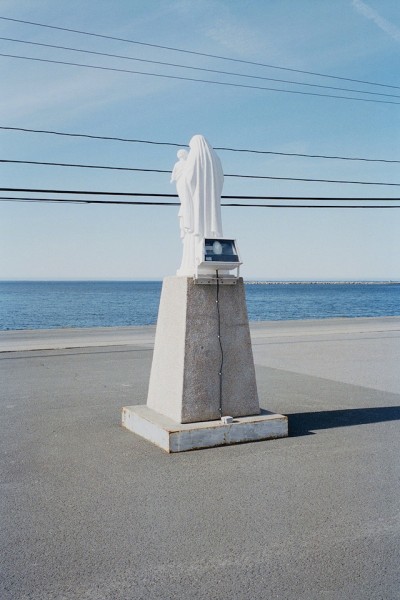
Each of the 20 photographs from Village is framed and matted with embossed text below the image, poetic-sounding descriptions in French and English. One representative work, Son propre nez (One’s own nose; 2015), shows the back of a white statue of the Madonna and child. Light clouds blur across the sky and the stone icons look out on the Gulf of Saint Lawrence. Telephone lines streak across the photograph, and a box is affixed to the back of the large pedestal, wired to the ground. One might try to create a connection between the caption and this image; this could be variably fruitful or fruitless.
After arriving in Quebec, the artists found themselves thrust into conversations about Canada’s language politics. These conversations led them to wonder about the languages spoken in the region before the French started setting traps and planting flags. Working with a research group, Källström and Fäldt identified pre-colonial names of places they photographed and the First Nation origins of contemporary place names. The photographs’ captions are French and English translations of those names from Algonquin, Mi’kmaq, and other languages. The original places names are both obscured, as they are not disclosed, and magnified, as their translations are what viewers have to ground the photographs. The exhibition provides no indication of where exactly the photographs were taken, but the accompanying artists’ book includes an index that notes, for example, that Son propre nez was taken on the shores of Détroit d’Honguedo.
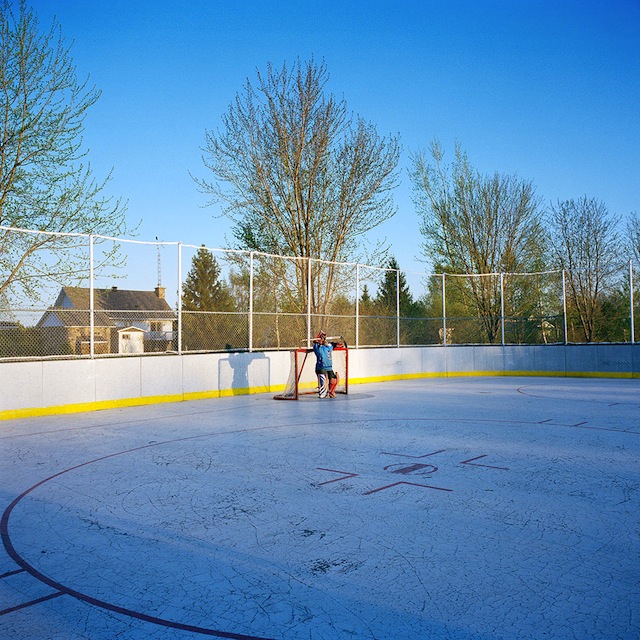
Källström and Fäldt unabashedly assumed the role of tourists, knowing they could neither be Canadians nor linguists nor anthropologists. They took as inspiration Swiss photographer Robert Frank’s 1958 The Americans, a sort of photographic Democracy in America. Noting that in this tradition of photography objective and descriptive captions are standard, Källström and Fäldt play with their titles, drawing upon more than what is seen on the surface. The titles dig beneath layers of colonialism and gesture at that which might otherwise remain unobserved.
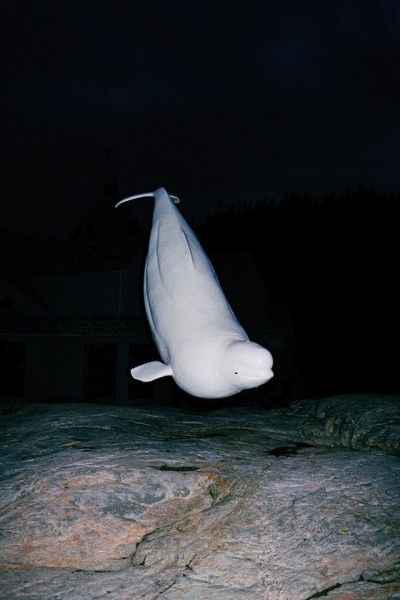
Källström and Fäldt capture tokens of Canadian culture in many pieces, such as a celebration of Quebec’s La fête nationale, a cannon ball from a historic battle, and a cheerleading squad, which to the artists’ Swedish perspective is a uniquely North American phenomenon. Lieu où l’on ramasse des oeufs (Place where they gather eggs; 2015) pictures a lone goalie stationed in front of a net, presumably in the middle of a hockey game. The outdoor rink is cracked and scratched. Sparse trees shadow the rink and a number of suburban-looking homes are seen in the distance.
The scene is commonplace — an everyday, if slightly cliché, depiction of life in Canada. A straight documentary photographer might stop there, but the text inflicts the history of conquest on this almost idyllic image. The place name seems to be in deeper conversation with the photograph than in Son propre nez. If one doesn’t think about it too much, they might imagine the goalie is gathering eggs rather than deflecting pucks. There’s humor to this pairing, and it begs one to linger on the photograph.
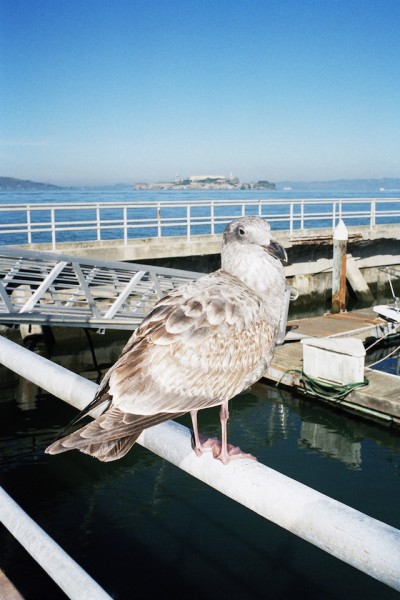
In San Francisco, Källström and Fäldt were introduced to a local resident and Native Californian who helped them identify four sites in San Francisco where Yelamu villages stood before Spanish colonization. These villages were located near what is now the Presidio, Mission Creek, Visitacion Valley, and Mission Dolores. The artists were told that these villages’ names translate, respectively, to “Place of Rest,” “Place of Barn Owl,” and “Place of Food”; the translation for the village near Mission Dolores was not determined. Källström and Fäldt acknowledge that a week’s worth of historical and linguistic research on-site does not qualify as scholarly inquiry, but, again embracing the role as outsiders, they worked with what they could uncover during their time in residence.
This work, titled High Hills after an apocryphal etymology of the word “California,” comprises four large color prints from each of the four sites and a series of small black and white prints. The large photographs are adorned with brass, museum-like inscription plates. The plates carry the villages’ names translated in English and Spanish.
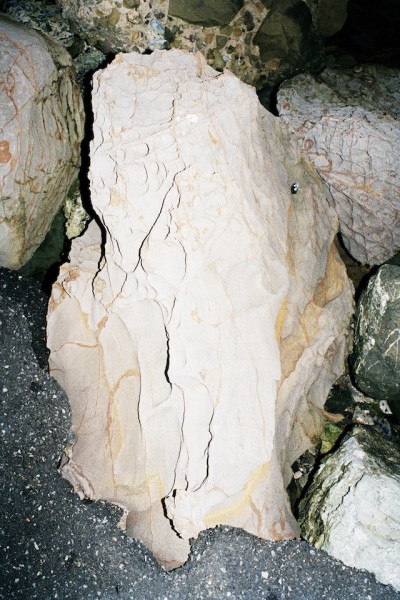
Place of Rest (2015) exemplifies the artists’ approach in this project. In the foreground, a seagull stands on the railing at a marina. The bird looks askance at the the photographer, its back turned toward him or her. The crisp blue sky melts into a the equally blue bay. Alcatraz Island and Penitentiary rest atop the choppy sea, just beyond the seagull. This photograph resembles tourist imagery more than most works in Village / High Hills. The scene is quintessentially tourist, down to the cocky gull, and is intentionally cliché, like Lieu où l’on ramasse des oeufs. Place of Rest, as with the other three large photographs, is presented in a 3:2 aspect ratio, which is used by classic 35mm film cameras and many DSLRs. This ratio recalls amateur and tourist photography more than some of the images in Village with 1:1 or other less common ratios.
Viewers will readily recognize the location of Place of Rest, and they may struggle or succeed to superimpose a Yelamu village over a strongly held image of San Francisco’s northern neighborhoods. Place of Food (2015) operates differently, opting for a close-up view of rocks, asphalt, and rubble in Visitacion Valley. The image resembles a rudimentary seawall, with what appears to be green algae garnishing rocks buried deep in the scree. Nonetheless, Place of Food is more abstract, Visitacion Valley is less spectacular, and viewers may approach this photograph with less firm associations.
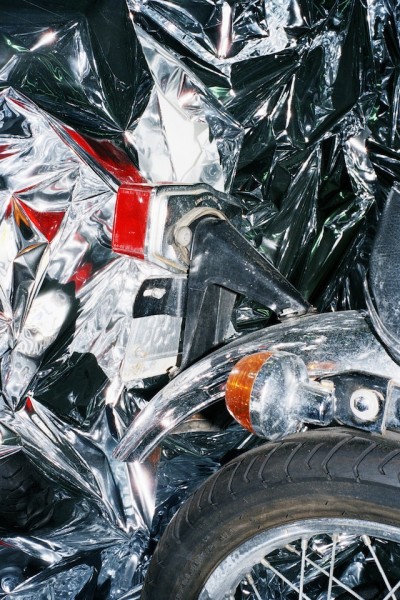
The inscription plate on the photograph for the village near Mission Dolores is blank. In this work, titled No Translation (2015), Källström and Fäldt commit the ultimate tourist act: they insert themselves into the photograph. The artists can be seen in at least two photographs from Village, but No Translation is an ambiguous image of the tail end of a motorcycle set against a chaotic metallic background. Though many viewers wouldn’t know this, No Translation is a detail installation shot of the exhibition that preceded Village / High Hills at CULT, which is in the Mission District. The photograph acknowledges the artists’ and the gallery’s roles in the continued transformation of the Mission District, often associated with colonialism. This acknowledgment is neither apathetic nor nihilistic, nor does it offer a solution; but present is at least an awareness of one’s individual place in a complex history.
With both Village and High Hills, I experience some ambivalence about the decision not to cite the original place names. These places and their historical names remain hidden; it’s as if the artists only present faint evidence of their existence. This causes some ethical unease, but in the end it may not be problematic. We can’t expect visiting Swedish artists to entirely excavate our past for us; as San Franciscans or Californians (or as Québécois), this is our work to do.
‘Village / High Hills’ runs through April 25, 2015, at CULT | Aimee Friberg Exhibitions in San Francisco. More information and details here.